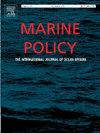Advancing multi-use in offshore wind energy planning: Perceived opportunities and barriers in southern New England, U.S.
IF 3.7
2区 社会学
Q2 ENVIRONMENTAL STUDIES
引用次数: 0
Abstract
Offshore wind energy development has been accelerating at a rapid pace around the world to address renewable energy goals. As a new use of ocean space, offshore wind developments can create spatial and temporal conflicts with existing ocean uses. The concept of multi-use, which spans from promoting co-existence of uses to identifying synergies between uses, has become an important framework for marine spatial planning and offshore renewable energy development in Europe, where offshore wind farms have been integrated with aquaculture and tourism, among other uses. In the United States, however, where offshore wind energy is at a more nascent stage, multi-use concepts have not been applied to the planning, permitting, and development processes, and multi-use has been considered on a more ad hoc basis. Offshore wind development in the U.S. has consequently been rife with conflict, particularly with the commercial fishing industry, and a lack of consistent policy on multi-use has led to missed opportunities to consider ways to build on synergies. To better understand the state of multi-use in the U.S., we interviewed key informants in the Southern New England region from federal and state agencies, and development, research, conservation, and fisheries sectors. Based on the interviews, we identified perceived opportunities and barriers to multi-use among interviewees, and perceptions of the state of multi-use. Responses were used to share lessons learned in the region, and to develop a set of recommendations related to the implementation of multi-use policies in the U.S.
推进海上风能多用途规划:美国新英格兰南部的机遇和障碍
为了实现可再生能源的目标,世界各地的海上风能开发一直在快速加速。作为海洋空间的一种新用途,海上风电的开发可能会与现有的海洋用途产生空间和时间上的冲突。从促进用途共存到确定用途之间的协同作用的多用途概念已成为欧洲海洋空间规划和近海可再生能源开发的重要框架,在欧洲,海上风电场已与水产养殖和旅游业等用途结合起来。然而,在美国,海上风能还处于初级阶段,多用途概念还没有应用到规划、许可和开发过程中,多用途是在更临时的基础上考虑的。因此,美国的海上风电开发充满了冲突,特别是与商业捕鱼业的冲突,而且缺乏一致的多用途政策,导致错失了考虑如何建立协同效应的机会。为了更好地了解美国的多用途状况,我们采访了新英格兰南部地区联邦和州机构以及开发、研究、保护和渔业部门的关键线人。基于访谈,我们确定了受访者对多用途的感知机会和障碍,以及对多用途状态的感知。这些回应被用来分享该地区的经验教训,并制定了一套与美国实施多用途政策有关的建议
本文章由计算机程序翻译,如有差异,请以英文原文为准。
求助全文
约1分钟内获得全文
求助全文
来源期刊

Marine Policy
Multiple-
CiteScore
7.60
自引率
13.20%
发文量
428
期刊介绍:
Marine Policy is the leading journal of ocean policy studies. It offers researchers, analysts and policy makers a unique combination of analyses in the principal social science disciplines relevant to the formulation of marine policy. Major articles are contributed by specialists in marine affairs, including marine economists and marine resource managers, political scientists, marine scientists, international lawyers, geographers and anthropologists. Drawing on their expertise and research, the journal covers: international, regional and national marine policies; institutional arrangements for the management and regulation of marine activities, including fisheries and shipping; conflict resolution; marine pollution and environment; conservation and use of marine resources. Regular features of Marine Policy include research reports, conference reports and reports on current developments to keep readers up-to-date with the latest developments and research in ocean affairs.
 求助内容:
求助内容: 应助结果提醒方式:
应助结果提醒方式:


